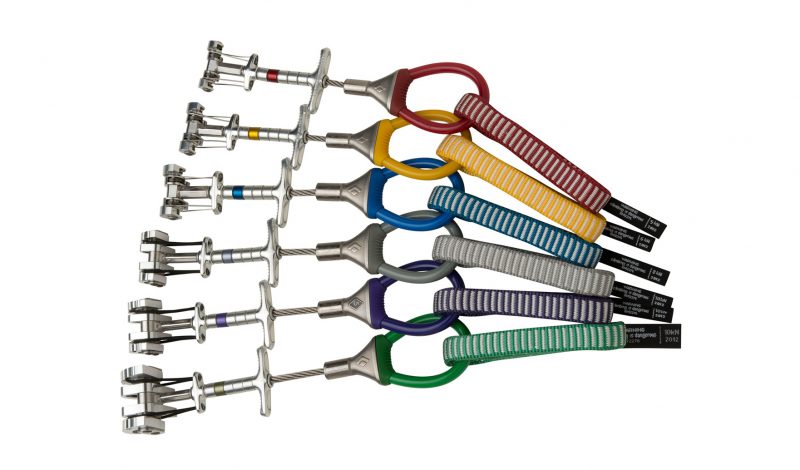Forget nuts and bolts. Cams are the backbone of every rack
There’s nothing quite like loading up your harness with a full rack of Spring-Loaded Camming Devices (SLCDs). Or, as climbers simply call them, “cams.”
I love all the preparation that goes into racking each cam on my harness in just the right way. I love the challenge of thinking ahead about pieces to bring on that particular pitch; then doubling up with a few “just-in-case” cams because you know you’ll regret it if you don’t. I love the clank and jangle of the gear, shifting as you move.
Cams are some of the most interesting, useful and well-engineered pieces of climbing gear made. Cams are devices with retractable cam lobes that, under the tension of a spring, can be wedged or placed inside cracks of rock; when the camming unit is weighted, the cam lobes apply an outward force against the rock that secures the unit from pulling out.
Due to their moving parts, cams fall into a classification of climbing gear known as “active protection,” as opposed to “passive protection,” which would be pro such as nuts, which contain no moving parts.
What’s so great about cams is how easy they are to place—and remove—with just one hand. They’re strong, relatively inexpensive, and long lasting. A well-placed cam in solid rock is, for all intents and purposes, just as strong as a bolt. A single cam typically costs between $30 and $80, depending on brand and size. And most cams will last for many years of normal use before needing to be replaced.
Anatomy of a Cam
Head: The head of a cam is where you will find the lobes. Most cam heads contain four lobes, but some—TCUs (Three Cam Units)—contain three. There is only one brand of cam with a two-cam head.
Stem: The stem is the long centerpiece connected to the cam head. There are several types of stems.
Rigid Stem: a rigid-stem cam is made of solid aluminum. The very first cams used this design, but today rigid stem cams are mostly obsolete today due to the fact that they can be dangerous in horizontal placements.
Flexible, Single-Stem: Constructed of cable, flexible single-stem cams are the most common stem designs today. Flexible stem cams are an improvement over rigid-stem cams due to the fact that they cause less “walk”—which is the term that describes a situation when a cam shifts within the crack, potentially into an undesirable configuration.
Flexible, U-Stem: A U-stem attaches to the cam head in two places. There’s no real difference, necessarily, between U-stem and single-stem cams, though U-stems can sometimes be slightly sturdier when retracting the trigger. Also, U-stems can sometimes add more width to the cam head, potentially limiting their placement options.
Trigger: The cam trigger allows you to operate the cam by retracting the lobes via the trigger wires. Pulling back against a spring, located inside the cam head, creates tension. If you have really big hands or fat fingers, it’s worth checking out the triggers on different brands to make sure you can actually operate the cam easily.
Sling: At the end of the stem is a loop of webbing called the sling, which allows you to clip the cam to the rope. Slings are often, but not always, colored in order to indicate the size of the cam at a quick glance. There is no industry-wide standard between color and size (I.e., red = .75”)—though that would be useful. Slings are either made of nylon or Dyneema. There are pluses and minuses for both materials. Dyneema is lighter and more resistant to UV rays, while Nylon is more susceptible to damage from UV but more durable overall.

Sizes
Individual cams come in a huge range of sizes, from micro-sized cams that fit the tinniest 1/4”-sized fissures of rock, to 6”, 7”, even 8”-sized off-width/chimney-sized cracks.
When evaluating a set of cams, it can be helpful to look at what the total range of sizes the full set covers. Also, it is helpful to look at how much (or little) overlap there from one size to the next.
Finally, consider the areas you will be climbing, and the type of climbing you want to be doing. In areas such as the Shawangunks of New York, you rarely need very many (if any) large pieces. But in Yosemite, where single pitches can often range from fingers to off-width, you might need a greater number of cams to cover that range of sizes. Of course, cam size is extremely important in places such as the crack-climbing destination of Indian Creek, where individual pitches often require up to 12 of the exact same-sized cam. In order to climb here, you either need a $10,000 worth of cams or, more likely, you have to learn to share racks with your friends and fellow craggers in order to safely lead most pitches.
Cam Range
The “range” of a cam is what size crack that cam fits into, safely. (Proper cam placement is beyond the scope of this article—seek professional instruction on how to properly place cams.)
In general, the more range a cam has, the more useful it may be in that you’re more likely to choose the right piece for the right placement on your first try.
Further, when cams have larger ranges, you may need to carry fewer of them because one size will fit in more places. Also, when cams have greater ranges, they are less likely to get stuck in the crack (a problem when you “over cam” the unit by shoving a cam that’s too large for the crack in which it’s placed).
That said, the reality is that it’s not always true that larger ranges automatically means better cams.
In terms of cam range, cams with a “double axle” head provide much more range than single-axle heads. The axel is the bar (or set of bars) around which the cam lobes pivot.
Hybrid or Offset Cams
If you climb in an area with pin scars, or potentially just irregular conglomerate rock, or just with cracks that flare outward, having a set of hybrid or “offset” cams can be a lifesaver, literally. These cams are distinguished by the fact that two of the four cam lobes are slightly larger in size.
Another note about pin scars and flared cracks: it’s generally not a good idea to place TCUs in these situations. One of my favorite stories is from my early days of climbing in Yosemite, when my friend took a huge 40-foot fall on the Free Blast, ripping a TCU out of pin scar in the fall, and subsequently breaking his ankle. The nurse (not a climber) at the Valley hospital chastised my buddy, saying, “Bro, everyone knows you don’t place TCUs in pin scars!”
If even the old nurse in Yosemite knows this, so should you.
A Word on Sharing Racks
When I first started climbing, I bought cheap, off-brand cams because that was all I could afford. It got me out on the rock quickly, and I was able to start learning right away, so there was certainly value in that. However, once I was at a certain level, and I was comfortable climbing with various partners of different levels, I quickly realized the downfall of my choice to get off-brand cams. Nobody else had them, which made it difficult for us to combine our racks to tackle the objectives we wanted to climb.
Long story short, I had to ditch those budget cams and go for the more tried-and-true brands. In the long run, I spent more money than had I just invested in a full set of brand-name cams from the get-go.
The reality about climbing is that your trad rack is not really yours, but it belongs to both you and the people you climb with. In general, you will find it necessary to share sets of cams with your friends. Therefore, it can be a good idea to ask your partners what cams they have, and then consider buying the same brand.
Familiarity with a brand of cams is one of the most important factors in terms of how effective those cams will be. Why? Because it helps to know, at a glance, what size cam you want, and then quickly find that cam amid a dozen or so pieces cluttered together on your harness.
Choosing a brand is a big decision and in general, once you choose a brand, it’s a good idea to stick with it as you build up your rack over the years.














